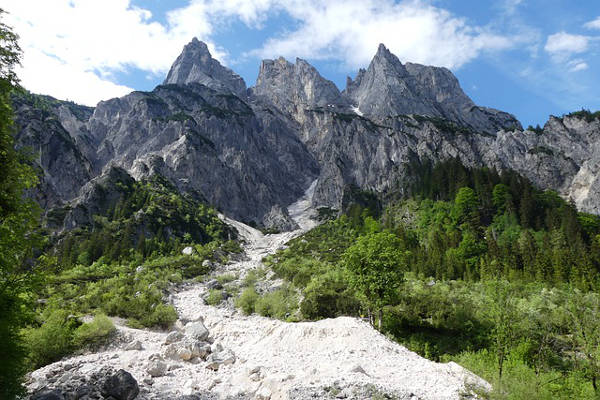Why Are The Alps Mountains So Prominent?
Unveiling the Majesty: Why the Alps Mountains Stand So Tall
Why Are The Alps Mountains So Prominent

The Alps Mountains, with their awe-inspiring peaks, dramatic landscapes, and rich cultural heritage, have long held a special place in the hearts of explorers, nature enthusiasts, and adventurers. But what makes the Alps so remarkable and prominent among the world’s mountain ranges? In this blog post, we embark on a journey of discovery to unravel the geological, ecological, and cultural factors that contribute to the prominence of the Alps Mountains.
Geological Origins: The Alpine Orogeny
The Alps Mountains owe their prominence to a fascinating geological history that dates back millions of years. The primary geological factor that has shaped their prominence is the Alpine orogeny.
Alpine Orogeny:
The term “orogeny” refers to the process of mountain building through tectonic plate interactions. The Alps Mountains are the result of the ongoing collision between the European Plate and the African Plate. This collision initiated during the Eocene epoch approximately 55 million years ago.
Tectonic Collision:
The collision created a subduction zone where the denser African Plate was forced beneath the European Plate. This process led to the uplifting of vast rock layers, forming the Alps.
Continual Uplift:
Over millions of years, the movement of these tectonic plates continued to exert immense pressure. Causing the Alps to rise further and giving them their towering stature.
Geographic Location: Central Europe’s Heart
Another key factor contributing to the prominence of the Alps is their strategic geographic location in the heart of Europe.
Central European Position:
The Alps are situated in central Europe, spanning multiple countries, including France. Switzerland, Italy, Austria, and Germany. This central location makes them easily accessible to a vast population of Europeans and international travelers.
Surrounded by Lowlands:
The Alps are surrounded by lowland areas, which enhances their visual prominence. The abrupt rise of these massive mountains from the surrounding plains creates a striking contrast and makes them visible from afar.
Majestic Peaks: Towering Heights
The impressive heights of the Alps are one of the most visible aspects of their prominence.
Mont Blanc:
Mont Blanc, the highest peak in the Alps and Western Europe. Soars to an elevation of 4,810 meters (15,781 feet) above sea level. Its iconic white dome is a symbol of the Alps’ grandeur.
The Matterhorn:
The Matterhorn, often regarded as one of the world’s most iconic mountains. Reaches an elevation of 4,478 meters (14,692 feet) and is known for its distinctive pyramid shape.
Numerous Four-Thousanders:
The Alps are home to numerous peaks that exceed 4,000 meters in elevation, adding to their grandeur and prominence.
Glacial Activity: Shaping the Landscape
The Alps’ history of glaciation has played a pivotal role in shaping their distinctive landscape.
Glacial Erosion:
Glaciers moved forward and backward over the Alps during a series of ice ages that occurred during the Pleistocene epoch. This glacial activity carved deep valleys, cirques, and U-shaped formations, creating the dramatic and picturesque landscapes we associate with the Alps.
Moraines and Lakes:
Moraines, ridges of unconsolidated debris left behind by retreating glaciers, enhance the natural splendor of the Alps. Alpine lakes, formed in glacial cirques, add to the region’s allure.
Biodiversity: Unique Alpine Flora and Fauna
The Alps Mountains are notable geologically and have a variety of environments.
Unique Flora:
The Alps are home to a wide range of plant species, many of which are adapted to the harsh alpine conditions. From alpine meadows to rare alpine flowers, the region’s flora is as diverse as it is stunning.
Wildlife Haven:
The Alps provide habitat for diverse wildlife, including ibex, chamois, marmots, and golden eagles. The protection of these species and their habitats adds to the Alps’ prominence as an ecological hotspot.
Cultural Significance: A Rich Heritage
The Alps Mountains’ rich cultural history has a tremendous impact on their notoriety.
Alpine Culture:
The Alps have a rich cultural history, with traditions and lifestyles shaped by the mountain environment. Alpine culture includes distinct music. Cuisine, festivals, and architecture that are celebrated and admired worldwide.
Tourism and Adventure:
The Alps have become a hub for outdoor adventure and tourism, drawing visitors from all over the world. The prominence of the Alps as a tourist destination adds to their global recognition.
Literary and Artistic Inspiration:
The majestic beauty of the Alps has inspired countless artists, writers, and poets over the centuries. Works of literature, paintings, and music that celebrate the Alps continue to captivate audiences.
Conclusion: A Prominence Beyond Measure
The prominence of the Alps Mountains is multifaceted. Encompassing geological forces, geographic positioning, majestic heights, glacial history, biodiversity, cultural significance, and much more. As we gaze upon their towering peaks and explore their pristine landscapes, we are reminded that the Alps are not just mountains. They are an embodiment of the majesty and wonder of the natural world. Their prominence is not only physical but also deeply rooted in the human spirit and our enduring fascination with nature’s grandeur




